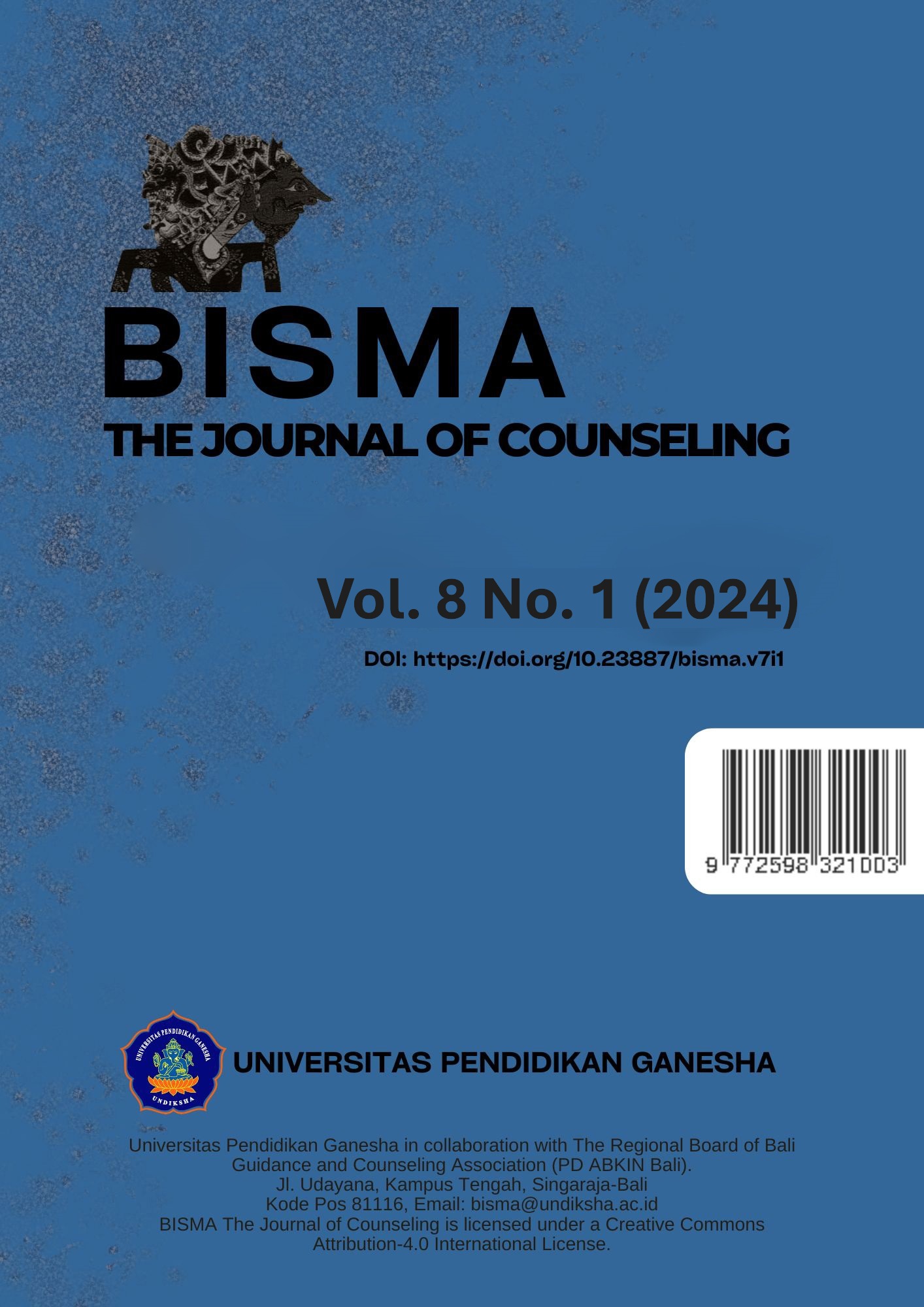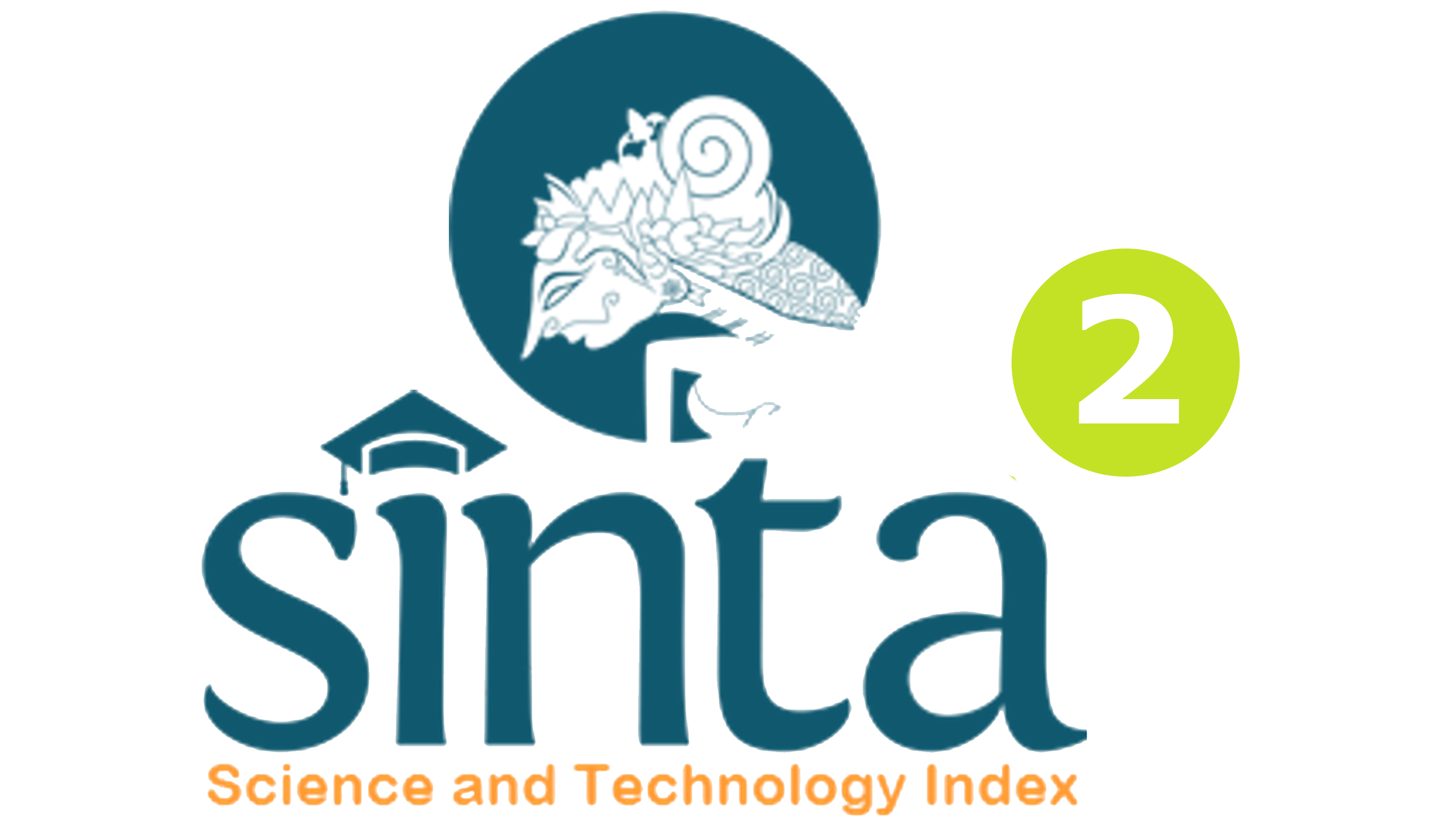E-book Integrated Video Tutoring with Symbolic Modelling Techniques to Increase the Self-control of Bullying Perpetrators
DOI:
https://doi.org/10.23887/bisma.v8i1.84341Keywords:
Bullying, E-Books , Group Guidance, Self-Control, Symbolic Modeling TechniquesAbstract
Bullying has become a worrying global issue with increasing prevalence in various countries. Bullying is increasing in the world, one of which is due to lack of self-control. Group guidance using information technology such as video media is rarely implemented. The aim of this research is to develop a video-integrated group guidance E-book with symbolic modelling techniques to increase the self-control of bullies, using R & D research with the ADDIE model which includes the analysis, design, development, implementation and evaluation stages. The research sample involved 20 perpetrators of bullying. The research results revealed that (1) E-book integrated video group guidance with symbolic modelling techniques was considered very suitable for use by guidance and counseling teachers (2) Video integrated group guidance with symbolic modelling techniques was effective in increasing the self-control of bullies. The experimental group showed a much higher change in self-control scores for bullies than the control group (U= 10,000, Z= -3025, p<0.05). These findings explain that E-book group guidance integrated with video with symbolic modelling techniques can be an alternative for increasing the self-control of students who are bullies at school.
References
Bandura, A., & Walters, R. H. (1977). Social learning theory. Englewood cliffs.
Basyoni, A., Bee, M., S., H., Seng, G., & H. (2020). The effectiveness of using students’ created digital storytelling in enhancing Saudi ninth graders’ critical listening skills. Journal of Education and Social Sciences, 16(1), 58–72. https://doi.org/https://www.jesoc.com/wp-content/uploads/2020/12/JESOC16-030.pdf.
Bollen, L., Kampen, P., Baily, C., Kelly, M., & Cock, M. (2017). Student difficulties regarding symbolic and graphical representations of vector fields. Physical Review Physics Education Research, 13(2). https://doi.org/10.1103/PhysRevPhysEducRes.13.020109.
Bong, S. H., Kim, K. M., Seol, K. H., & Kim, J. W. (2021). Bullying perpetration and victimization in elementary school students diagnosed with attention-deficit/hyperactivity disorder. Asian Journal of Psychiatry, 62, 102729. https://doi.org/10.1016/j.ajp.2021.102729.
Chai, C. S., Chiu, T. K. F., Wang, X., Jiang, F., & Lin, X.-F. (2022). Modeling Chinese Secondary School Students’ Behavioral Intentions to Learn Artificial Intelligence with the Theory of Planned Behavior and Self-Determination Theory. Sustainability, 15(1), 605. https://doi.org/10.3390/su15010605.
Chen, Y. (2022). How to improve the quality of youth education in developing countries. Proceedings of the 2021 International Conference on Education, Language and Art (ICELA 2021), 637(Icela 2021), 266–270. https://doi.org/10.2991/assehr.k.220131.048.
Damayanti, S., Nofia Sari, O., & Bagaskara, K. (2020). Perlindungan Hukum terhadap Anak Korban Bullying di Lingkungan Sekolah. JURNAL RECHTENS, 9(2), 153–168. https://doi.org/10.36835/rechtens.v9i2.791.
Dasmana, A., Wasliman, I., Ujang, ;, Barlian, C., & Yoseptri, R. (2022). Implementation of Integrated Quality Management Strengthening Character Education in Realizing Pancasila Student Profiles. International Journal Of Graduate Of Islamic Education, 3(2), 361. https://doi.org/10.37567/ijgie.v3i2.1342.
Evans, C. B. R., Smokowski, P. R., Rose, R. A., Mercado, M. C., & Marshall, K. J. (2018). Cumulative Bullying Experiences, Adolescent Behavioral and Mental Health, and Academic Achievement: An Integrative Model of Perpetration, Victimization, and Bystander Behavior HHS Public Access. In J Child Fam Stud. https://doi.org/10.1007/s10826-018-1078-4.
Gagnon, C., LeBlanc, L., Robert-Mazaye, C., Maïano, C., & Aimé, A. (2022). Intention to intervene in weight-related bullying in elementary school: A qualitative study of the perspectives of teachers and school counsellors. Teaching and Teacher Education, 118(2). https://doi.org/10.1016/j.tate.2022.103805.
Graham, S. (2022). Self-efficacy and language learning–what it is and what it isn’t. Language Learning Journal, 50(2), 186–207. https://doi.org/10.1080/09571736.2022.2045679.
Haltigan, J. D., & Vaillancourt, T. (2014). Joint trajectories of bullying and peer victimization across elementary and middle school and associations with symptoms of psychopathology. Developmental Psychology, 50(11), 2426–2436. https://doi.org/10.1037/a0038030.
Hasyim, I., Utama, A. P., & Setiawan, B. (2022). Urgensi Pendidikan Bela Negara Dalam Membentuk Kecerdasan Sosial Peserta Didik Sebagai Daya Dukung Pertahanan Negara. Indonesian Journal of Social Science Education (IJSSE), 4(1), 1–10. https://doi.org/10.29300/ijsse.v4i1.6191.
Insani, B., Asradi, & Yaksa, R. A. (2022). Faktor Penyebab Perilaku Cyberbullying pada Peserta Didik. JAMBURA Guidance and Counseling Journal, 3(1), 26–33. https://doi.org/10.37411/jgcj.v3i1.1254.
Johanis, M. A., Bakar, A. R. A., & Ismail, F. (2020). Cyber-Bullying Trends Using Social Media Platform: An Analysis through Malaysian Perspectives. Journal of Physics: Conference Series, 1529(2). https://doi.org/10.1088/1742-6596/1529/2/022077.
Kaloeti, D. V. S., Manalu, R., Kristiana, I. F., & Bidzan, M. (2021). The Role of Social Media Use in Peer Bullying Victimization and Onset of Anxiety Among Indonesian Elementary School Children. Frontiers in Psychology, 12(April), 1–10. https://doi.org/10.3389/fpsyg.2021.635725.
Kapile, C., Nuraedah, N., Junarti, J., & Nugroho, F. (2023). Bullying and its Implications on Middle School Students and Teachers in Indonesia. AL-ISHLAH: Jurnal Pendidikan, 15(1), 813–822. https://doi.org/10.35445/alishlah.v15i1.2205.
Landoni, M., & Hanlon, G. (2007). E-book reading groups: Interacting with e-books in public libraries. Electronic Library, 25(5), 599–612. https://doi.org/10.1108/02640470710829578.
Laurensius, S., Situngkir, D., Putri, R., & Fauzi, R. (2019). Cyber Bullying Against Children In Indonesia. In Proceedings of the First International Conference on Social Sciences, Humanities, Economics and Law, 5–6. https://doi.org/10.4108/eai.5-9-2018.2281372.
Laws, S., Harper, C., Jones, N., & Marcus, R. (2013). Research for Development: A Practical Guide. Sage.
Melati, A. D., Fatimah, S., & Manuardi, A. R. (2022). Rational Emotive Behavior Therapy dalam Menangani Kecemasan Sosial Korban Bullying. FOKUS (Kajian Bimbingan & Konseling Dalam Pendidikan), 5(3), 200–206. https://doi.org/10.22460/fokus.v5i3.8642.
Nasution, A. E. (2019). E-Kompen (Elektronik-Komik Pendek) sebagai solusi cerdas dalam meningkatkan minat baca masyarakat Indonesia di era digital. IQRA`: Jurnal Ilmu Perpustakaan Dan Informasi (e-Journal), 13(1), 105. https://doi.org/10.30829/iqra.v13i1.4365.
Net, W. W. W. P., Munawaroh, S., Degeng, I. N. S., Atmoko, A., Lasan, B. B., & Fitriyah, F. K. (2023). Prevalence Aggressive Behavior from the Perspective of Bullying Victims and Demographic Characteristics : An Evaluation Environment Survey of the School. 1(4). https://doi.org/10.47750/pegegog.1.
Nurlia, A., & Suardiman, S. P. (2020). The phenomenon of bullying in junior high school students nowadays. International Journal of Education and Learning, 2(1), 7–13. https://doi.org/10.31763/ijele.v2i1.62.
Praptiningsih, N. A., & Putra, G. K. (2021). Toxic Relationship Dalam Komunikasi Interpersonal Di Kalangan Remaja. Communication, 12(2), 132. https://doi.org/10.36080/comm.v12i2.1510.
Pratiwi, I., Herlina, H., & Utami, G. T. (2021). Gambaran Perilaku Bullying Verbal Pada Siswa Sekolah Dasar : Literature Review. JKEP, 6(1), 51–68. https://doi.org/10.32668/jkep.v6i1.436.
Reknes, I., Visockaite, G., Liefooghe, A., Lovakov, A., & Einarsen, S. V. (2019). Locus of control moderates the relationship between exposure to bullying behaviors and psychological strain. Frontiers in Psychology, 10(JUN), 1–12. https://doi.org/10.3389/fpsyg.2019.01323.
Taştan, S. B., Mehdi, S., Davoudi, M., Masalimova, A. R., Bersanov, A. S., Kurbanov, R. A., Boiarchuk, A. V, & Pavlushin, A. A. (2018). The Impacts of Teacher’s Efficacy and Motivation on Student’s Academic Achievement in Science Education among Secondary and High School Students. EURASIA Journal of Mathematics Science and Technology Education, 14(6), 2353–2366. https://doi.org/10.29333/ejmste/89579.
Ummy Khaira, N., Susilawati, S., & Yanda, Y. (2023). The Problems of Bullying toward Students’ Learning Achievements at Grade V SD Negeri 23 Lolong. TOFEDU: The Future of Education Journal, 2(2), 462–467. https://doi.org/10.61445/tofedu.v2i2.75.
Wang, R. (2021). Application of Bandura’s social learning theory in the moral education of secondary vocational college students. Journal of Contemporary Educational Research, 5(8), 161–167. https://doi.org/10.26689/jcer.v5i8.2455.
Wardiani, R. T., Nurmala, M. D., & Handoyo, A. W. (2022). Pengembangan Modul Bimbingan dan Konseling untuk Pencegahan Bullying di SMA. Jurnal Fokus Konseling, 8(1), 1–7. https://doi.org/10.52657/jfk.v8i1.1706.
Wati, A. D. (2022). Edukasi Mengenai Bullying Pada Remaja Dengan Media Video Animasi. Khidmah, 3(2), 349–356. https://doi.org/10.52523/khidmah.v3i2.357.
Whale, K., Cramer, H., & Joinson, C. (2018). Left behind and left out: The impact of the school environment on young people with continence problems. British Journal of Health Psychology, 23(2), 253–277. https://doi.org/10.1111/bjhp.12284.
Widiatmoko, T. F., & Dirgantoro, K. P. S. (2022). Pentingnya Peran Guru Sebagai Pembimbing Dalam Mengatasi Perilaku Perundungan Di Kelas. JOHME: Journal of Holistic Mathematics Education, 6(2), 238. https://doi.org/10.19166/johme.v6i2.2072.
Wijaya, T. T., Jiang, P., Mailizar, M., & Habibi, A. (2022). Predicting Factors Influencing Preservice Teachers’ Behavior Intention in the Implementation of STEM Education Using Partial Least Squares Approach. Sustainability (Switzerland), 14(16). https://doi.org/10.3390/su14169925.
Zahra, S. L., & Hayati, M. (2022). Kondisi Self Awareness Pada Anak Korban Bullying. JECED : Journal of Early Childhood Education and Development, 4(1), 77–87. https://doi.org/10.15642/jeced.v4i1.1854.
Zulqurnain, M. A., & Thoha, M. (2022). Analisis Kepercayaan Diri pada Korban Bullying. Edu Consilium : Jurnal Bimbingan Dan Konseling Pendidikan Islam, 3(2), 69–82. https://doi.org/10.19105/ec.v3i2.6737.
Downloads
Published
Issue
Section
License
Copyright (c) 2024 Dea Aulia

This work is licensed under a Creative Commons Attribution 4.0 International License.









